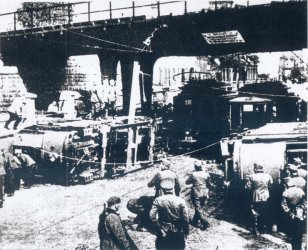
Polish barrickade from September 1939, under railroad bridge near Wolska and Bema street.
Wola during German occupation
In October 1939 flags with black swasticas where hanged in Warsaw. Almost five year period of occupation has started.
City was slowly recovering from damages, that were done during fights in September.Efforts were made to restart the City Power Plant and whole Network. Points of taking clean wather were created from hydrants. Main streets were clean of of the ruble, and the barrickades where dismantled.

Polish barrickade from September 1939, under railroad bridge near Wolska and Bema street.
In the middle of October Gasworks started to light some of the city streets. Step by step new factories and houses where reconnected to the gas net. Trams and buses where functioning again. As well as commuter trans. In the middle of November all most whole city was reconnected to the electricity and water.
However food supplies were very short. Food, cigarettes, soap and clothing street selling (it was forbidden by Germans to sell cigarettes like that) become main money source for thousands of people. In Wola on biggest market (Kercelego Square) Orly 113 stands remained from former 900.
Needles to say that much of the Warsaw population had housing problems. In some districts, including Wola a lot of the houses were damaged or destroyed due to the fights and bombardements that took place in September. Some of the famillies had nowhere to go. They where looking for any shelter possibile in remaing buildings all over the city.
Harsh winter has come. Many houses did not have glass in windows. Obviously people tried to fix them with glass or anything suitable. In addition there was serious problem with firewood or any other fuel.
Germans started extermination policy against Poles. Not only Germans but also Russians tried to exterminate as many polish people as possible. Area taken by Reich was successfully cleaned of Polish inhabitants, after they were taken of all positions they were sent to Generalne Gubernatorstwo (ger. Generalgouvernement für die besetzten polnischen Gebiete).
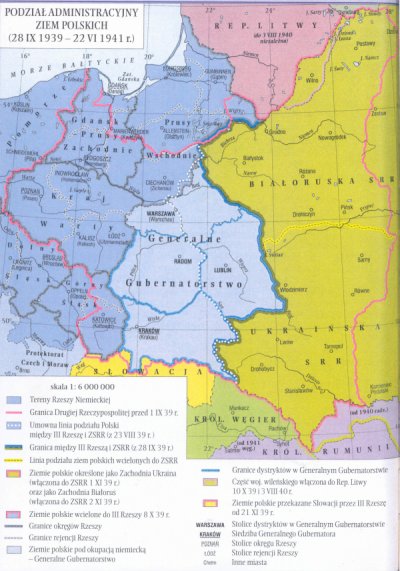
Polish territory until July 22 1941 (Atlas Historii Polski 2004)
Many Poles were taken to the concentration camps. Mass-scale murders and arrests begun. Same situation occurred in Generalne Gubernatorstwo. Main goal for Germans was to exterminate Polish intelligentsia.
Nazis even had definition for people that were dangerous for them. In memorial created by NSDAP Department of Racial Policy, with date 25th October 1939,in matter of treating Polish society, one can find these words:
"Definition of Polish intelligentsia includes mainly: priests, teachers (also lecturers), doctors, dentists, veterinarians, officers, important clerks, wealthy merchants, wealthy land owners, writers, redactors, and all the people with higher or medium education."
In respect to that instruction soldiers begun systematic action in order to destroy Polish nation. In 1940, action called AB-Aktion begun, under that name was hidden murder. Circa 3 500 Poles previously putted on special lists were killed in Palmiry near Warsaw. Others were transported to the concentration camps, in Germany.
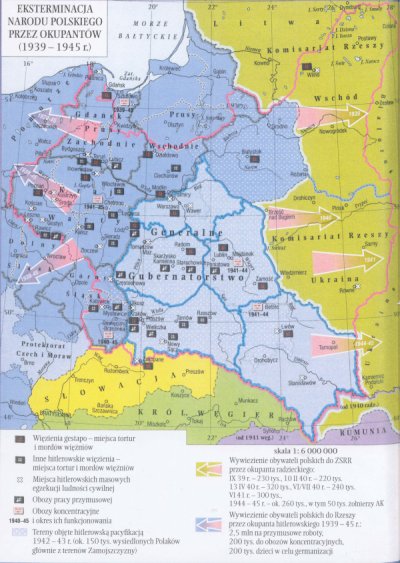
Extermination of Polish people (Atlas Historii Polski 2004)
Because of the large number of prisoners, Germans needed new camp placed in Poland, and so a huge one was built in Oswiecim, called by Germans Auschwitz. Place was choosed intently. Near was big railroad junction, that was important in transporting large numbers of prisoners. Camp begun to work in the middle of year 1940. Originally it was made especially for polish elites and those who were resisting Nazis. Later Jews, Russian soldiers and all kind of other prisoners were sent there. First transport of hundreds of Polish political prisoners, reached Auschwitz on June 14 1940. According to historians nearly 1,3 million prisoners were sent here (most of them were Jews from all over Europe) including 150 000 Poles. Nearly 1,1 million people died in Auschwitz, some sources are telling about even 4 millions. However this second number is not taken seriously by most of the historians.
Soviet Union was no better than Nazis. Successfully implementing guidelines of secret protocol about destroying Polish strive to independence, which was included in Ribentropp - Molotov pact signed on 28th August 1939. Area taken by USSR, land owners lost their lands, industry and banks were nationalized. Russians just like Germans arrested clerks, officers, land owners and national activists, circa 300 000 people were captured. Between 1940 and 1941, four deportations of Polish people took place. Over 1,2 - 1,3 million people were sent to gulags in European part of USSR, Kazakhstan and Siberia.
In german and soviet POW camps, thousands of polish officers were kept. They were captured during fights in September 1939. Fate of many of them was tragic.
In May 1940, governor of occupied Polish territory Hans Frank said:
"... As a result (of action AB), several thousand people from Poland will have to die, especially ideological polish leaders.. Suspicious people must be exterminated immediately.
Prisoners sent from Generalgouvernement to camps in III Reich, should be either sent back to us so they can be covered by AB Aktion or they must be exterminated on place."
Stefan Starzynski brave president of Warsaw was arrested by Nazis on 7th October 1939. First he was kept imprisoned in Pawiak, after that he was transported to Moabit prison in Berlin and later to concentration camp in Dachau. He was murdered, probably on 19th March 1944. Documents about president's death were kept by STASI (east Germany Ministry for State Security, ger. Ministerium für Staatssicherheit), they are still kept secret.
Warsaw, was not passive towards German cruelty. During autumn of 1939 first organizations of Polish Resistance started functioning. During the night of 26/27 September was created in Warsaw Sluzba Zwyciestwu Polski (Service for Poland's Victory), which was later (13th November 1939) transformed into Zwiazek Walki Zbrojnej (ZWZ) (Union of Armed Struggle), this organization was subordinate to Polish Government-in-exile. Later (14th February 1940) ZWZ was transformed by general Wladyslaw Sikorski into Home Army.
ZWZ was only one of many resistance organizations subordinate to Polish Government-in-exile, other most significant were: Polska Organizacja Zbrojna, Bataliony Chlopskie, Organizacja Wojskowa, Zwiazek Jaszczurczy and many more.
Thanks to integration action, which has ended in 1943, Home Army became the biggest underground army in Europe, with total number of troops counting circa 500 000 men and women.
In November 1939, Germans closed all polish schools in Warsaw. Avoiding the epidemic was serving as pretext to such doing. Afterwards only elementary schools and few vocational schools were reopened. Thanks to interventions of rectors few universities and higher schools were allowed to make final examination, to those students which had finished learning in 1939.
Specialists from NSDAP Department of Racial Policy ascertained:
" ... Universities and other higher schools, vocational and high schools, are centers of constant raising in chauvinistic polish attitude, and therefore they must be closed...
Only elementary schools will be allowed, however, they will be permitted only to learn most basic knowledge like: counting, reading and writing.
Learning subjects important from national point of view like: history, geography, literature, or gymnastics is excluded..."
And so elementary schools that were reopened in 1940, did not have lessons like: history, geography, Polish literature and knowledge about modern world. As a reaction to that was immediate development of underground teaching. Including even universities level.
In occupied Warsaw aggressor started intense persecution over citizens with Jewish roots. They were made to wear armbands with David star, as a mark of being Jew. They were tasked on doing variety of jobs, such as cleaning city from rubble, absolutely without any payment.
On October 12 1940, governor of Warsaw District Ludwig Fischer has signed official regulation about creating a ghetto in Warsaw. It's area was 2,6 square kilometers big. From Wola side ghetto border was made on Okopowa and Towarowa street.
Whole area was bordered with 3 meters high bricked wall, and Jews were made to built it by themselves. The ghetto itself was divided into two parts called little and big ghetto, these parts were connected with each other by wooden overpass, placed on second floor high, over Chlodna street along Zelazna street. In few points of the wall, gates were placed, so the communication between ghetto and "Aryan" area was possible. By the January of 1941, circa 400 000 Jews were placed inside the ghetto. Some of them were put there by force from other districts. As for the Poles that were housed inside the limits of ghetto, they had to leave their houses, and find new place to live. Ghettos were created also in other cities in Poland.
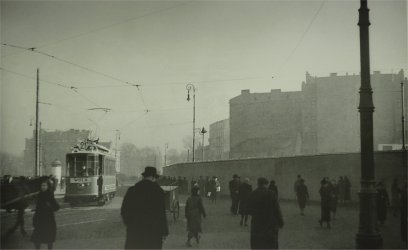 |
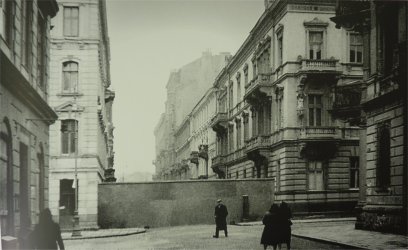 |
Wall of the ghetto
By march 1941 number of prisoners in ghetto has reached 460 000, because Jews living near Warsaw were putted here as well. It was a place with extremely harsh living conditions. Mortality was very high. Until second half of year 1942, most of the people there was dead. Little ghetto was closed on 22nd July 1942, numerous transports were sent to annihilation camps, most of them to Treblinka. Until the end of 1942 circa 300 000 Jews were transported from Umschlagplatz (ger. collection point or reloading point) near today's Stawki street near Dzika. On 18th January 1943, first fights between Jewish resistance led by Mordechaj Danielewicz and German soldiers started. Jews were victorious, transport was cancelled.
Poles were supporting Jews, as much as it was possible. Also citizens of Wola tried to help. Irena Sendlerowa, was living on Ludwiki street number 6 in apartment 82, she has rescued 2500 Jewish children.
Of course Germans did not let Polish people to go without a consequences of that.
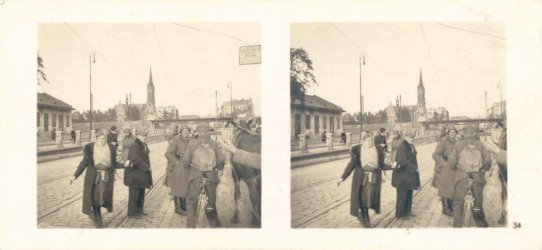 |
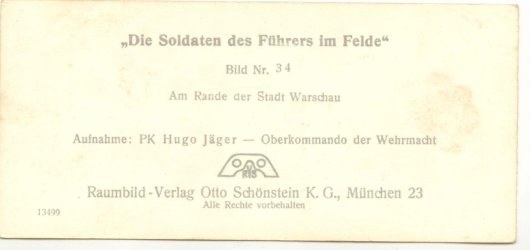 |
Control on Wolska street near overpass - German photography, made in stereoscopic technology (from Janusz Walkuski collection)
Realizing plan of elimination of Polish elites gestapo and german police were constantly arresting people mentioned on special list. New meanings of threaten were introduced such as lapanka (roundup). Arrested people were immediately sent to Pawiak prison (situated in ghetto), to concentration camps (mostly Auschwitz) or to be shot by firing squad. In that time executions on Poles took place mostly in Palmiry near Kampinos Forest.
And again Warsaw did not just stand and do nothing about that. 13 December 1940, was date of first strike in occupied Warsaw, workers in trams garage (Mlynarska street in Wola) demanded higher payments.
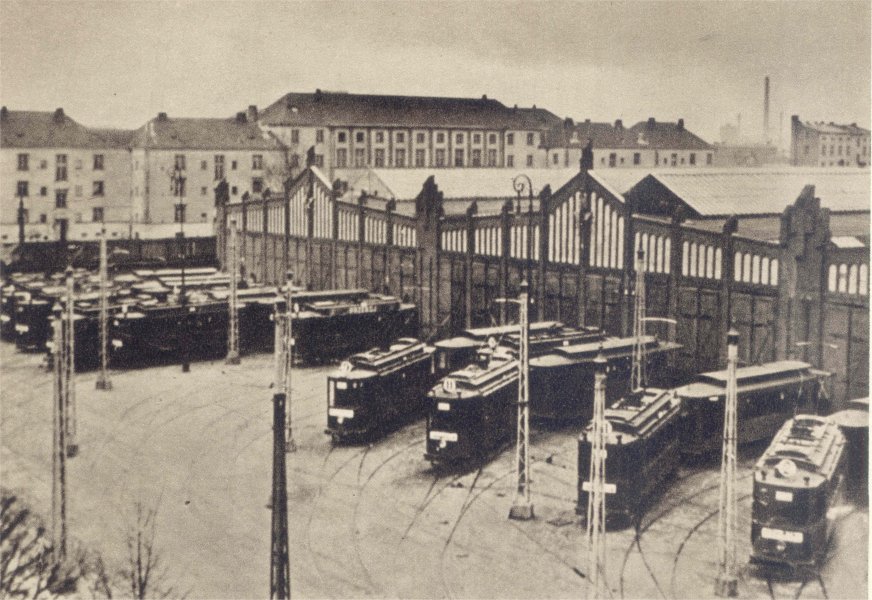
4 delegates of workers and 2 Polish directors are arrested. Other strike participants were saved from being shot by Gestapo, by one man that volunteered to die for them, he was PPS (abbreviation of one of the pre-war Polish political parties) member Karol Bem. He was sent to camp in Dachau, he was eventually shot there in April 1941.
On June 22nd 1941 Germans surprisingly attacked their former ally - USSR. In effect one of the enemies now became along with Great Britain and France Poland's ally. It was however very difficult situation for Poland. How to treat USSR after all they have done to Polish society during two years of war.
On August 13 and 14 Germans organized two huge roundups in Kercelego square, only man are arrested, after that they are transported to Germany, they have to replace German workers being now drafted to Werhmacht.
On November 13th 1941 Warsaw was bombarded again, this time by Soviets. 8 bombs dropped from very high altitude hit main railroad tracks near Kolejowa street, destroying also loading platform, and side tracks. Some bombs hit 3 houses near Miedziana and Srebrna streets, killing circa 50 people, and wounding 100.
Capitol is fighting more with every day. November 14 1941, near Gorczewska street on Wola, Germans found secret print shop, printing underground newspaper "Walka" ("Fight"), two men were killed and six arrested.
In this new circumstances communists started being active. Until now their situation was rather delicate. After all USSR, from very beginning of war was in very good relationships with Nazi Germany, helping them in fighting Allies. German planes during the Battle for Britain were flying on Soviet petrol. On the very day of German aggression on USSR, trains with supplies from Russia to III Reich were still active.
Founding meeting for underground Polska Partia Robotnicza ([PPR] Polish Workers Party) took place in house on street Krasinskiego 18, on 5th January 1942. Marceli Nowotko aka Marian became first party's secretary, he was one of the three men, dropped down few days later somewhere near Wiazowa street. They were part of "Initiate Group" sent to create communist party in Poland. Name of new party was missing any bound to pre-war party KPP (Polish Communist Party), which was rather not liked by Poles.
PPR duty was to achieve goals pointed by Comintern and Polish communists living in Russia. However from the first day, party members were fighting for leadership. After few months on 28th November, Marceli Nowotkko was shot dead on Karolkowa street. Responsible for this death was probably Zygmunt Molojec, he was brother of Marceli's biggest political rival, Boleslaw Molojec. Eventually Boleslaw took leadership in the party. However other members of PPR, considered this as anarchy, and so both brothers were killed soon after. Another party leader was chosen. He's name was Pawel Finder aka Pawel, he was from rich Jewish family of traders, and was bounded to communists since 1920s.
On 6th January Gwardia Ludowa (GL)(People's Guard) was created, however it was not until 28th March 1942 that it was fully shaped and intact. On 1 January 1944 GL was renamed for Armia Ludowa (AL)(People's Army). Both organizations were much smaller than Home Army. GL was only counting 5000 men, and AL circa 36 000 soldiers.
Communists from the beginning were claiming that Home Army is "standing with gun's to their legs", and were calling society to fight the Nazis immediately. However AL itself on that time was only focusing on propaganda (printing leaflets etc), as they thought that fighting Germans would increase their already huge terror over civilians.
During spring of 1942 on Wola, Nazis started to build a POW camp for Russians. It was situated on Gniewkowska street and called "Baraki" (Barracks), camp was built by the decision of Werhmacht commanders, and was bounded to the "Plan Ost"- Nazis attack on Russia. Localization was chosen due to the good communication possibilities, big junction station was near.
Camp build was started from bordering few hectares area with barbed wire, it was just near the railroad ramps, and railroad tracks connecting east with west. Large square was used as "camp field". Few accommodation barracks were built as well two administrative ones. Field was bordered with double barbed wire fence.
To make clear view for the guards, area between wires was cleaned out of any plants. This area was called "death zone". If anyone would try to escape through it, guard was ordered to shoot without warning. And they would shoot without hesitation because, for killing fugitive they were granted few days off the duty and were free to go home. For better view over residential area, it was surrounded with four guard towers equipped with spotlights, towers were located on the corners of the fence.
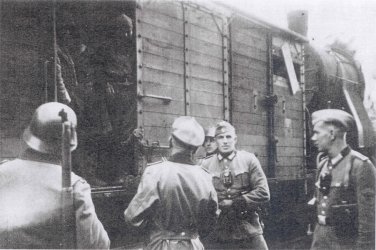 |
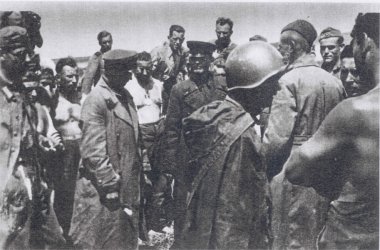 |
Soviet prisoners are being headed to camp in Warsaw.
Memories of Jerzy Janowski, he was 10 in that time:
"In 1942 Germans created complex of barracks, just along the main railroad tracks and street Gniewkowska, it was near our house on Sowinskiego street. It was filled with Soviet prisoners. On some evening, one of the prisoners, that was working outside the camp, escaped, due to the guard's inattention. After that he hide himself in the basement of our house.
I found him later in the evening when I went to the basement for coal. I was terrified, that man was using poor Polish, he asked me, for help and to keep his presence a secret. I told my mom, about whole situation, she was frightened but nevertheless, she took him to our apartment. He then was able to wash himself and was given some food, my father clothing and shoes.
We buried his uniform and boots near the house. In the morning we showed him eastern direction, and off he went, blending onto the crowd. In that inhuman times, it was good deed, maybe saving human life even."
On 13th May 1942, small team from "Wawer" organization, broke the windows in German agency on Wolska street, it was recruiting workers for the jobs in Germany.
Month later (15 June) unit Gwardia Ludowa, burned down petrol storage on Dworzec Zachodni (one of the Warsaw's railroad stations).
Night of 1st and 2nd September 1942 was date of another Soviet bombardment of Warsaw. Wola took the heaviest damage, as it was workers district, number of civilians deaths was the biggest. Most damaged area was Kercelego square, nearly 1000 stands were destroyed. Value of destroyed goods was circa 200 to 300 million zlote (pre-war zlote). Also nearly 100 houses were destroyed or damaged.
Last months of 1942 was beginning of Polish underground to activate. In the night from 7 to 8 October, Home Army units, started "Wieniec" (Wreath) action, its object was to attack all railroad tracks around the Warsaw in the same time. In Wola, around 2.10 am, two tracks were blown up (line from West Warsaw to Wlochy district), near Rozrzadowa station, another two that were destroyed, were part of line connecting Wlochy district with Warsaw Cargo station and circumference railroad. Action was successful, it has paralyzed train transport in the whole area for rest of the night and half of another day. The goal of this action was to disrupt transports of military supplies that were heading to the eastern front.
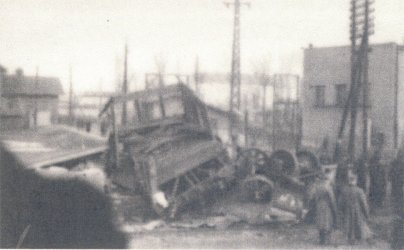 |
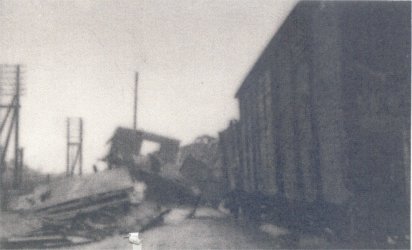 |
"Wieniec" action
In revenge, around 11 am Kercelak market, and private market on Przyopokowa street were surrounded by German police with assistance of navy-blue police. It was announced that all remaining stands along with their wares will be confiscated. Arbeitsamt officers, were checking documents of all people in the square. Most of them were arrested and packed on trucks, that were heading first to the camp on the Skaryszewska street, and later to the Germany. It took two days to steal and transport all goods from these two markets.
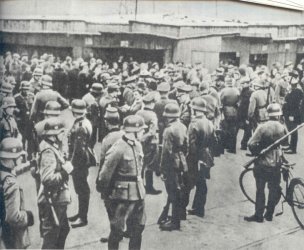 |
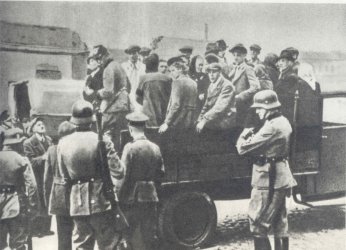 |
Roundup in Kercelak
On 16th November 10 prisoners from Pawiak were hanged on Mszczonowska street near crossroads, in revenge for "Wieniec" action. In four other points in Warsaw suburbs, and outside the city, another 40 people were hanged.
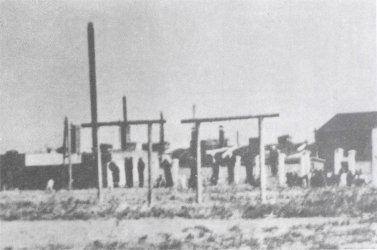 |
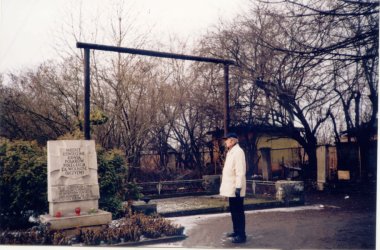 |
Execution on Mszczonowska street (photo on the right - J. Mankowska)
39 people were shot dead on the edge of Kampinos Forest, in area of Luze dunes. Nazis claimed that they have hanged 50 communists, the truth was that people with different political views were killed. None of them had anything to do with the night action.
In retaliation for killing 89 Poles, on 24th October 1942 GL made a series of bomb attacks. Guardians, threw grenades into German clubs ("Café Club" and "Mitropa") in Srodmiescie district (Downtown). Also print shop that was making collaborator newspaper "Nowy Kurier Warszawski" was blown up with grenades. Few Germans were wounded or killed during the attacks.
Two weeks later, unit of GL, was successful in stealing money from Centrala Komunalnej Kasy Oszczêdno¶ci (Central Municipal Savings Bank) on Traugutta street. Over million zlote were taken.
During the night of 31st December 1942 and 1st January 1943, Kedyw patrol from Home Army, attempted to blow up railroad overpass on Wola (on crossroads of railway and Wolska street, near Bema street.) Unfortunately mission was failure, because overpass was very well guarded, and Polish soldiers were exposed. Engineering squad had to retreat due to the heavy fire, there was possibility that explosives that were already armed can blow up any moment. Name of the action was "Wieniec II".
In the break of 1943 tactics of underground army was changed in the Warsaw. Increasing German terror, resulted in no further avoiding the military actions. Now it was violence for violence. Harassed with violence, Warsaw became aggressive like wounded animal, instead of surrender it started to fight back fearsomely.
In all districts of the city, special units were created, they were called Oddzialy Dywersyjno-Bojowe Kedywu Okregu Warszawskiego (Combat-Subversive Units of Kedyw of Warsaw District). Their missions included, systematical subversive actions, killing Gestapo and Abwehr agents as well as collaborators, that were sentenced by courts of Polish Underground. Those were elite units made of few men.
In all factories, but especially on Wola sabotage units were created. Some of these units were placed in Fabryka Karabinow (Arms Factory) on Dworska street 29/31, in "Lilpop, Rau and Loewenstein" factory on Bema street 65. In West Warsaw and situated near block stations, and junctions: station 4 Warsaw Czyste, station 5 Warsaw Bema, Warsaw Rozrzadowa, were facing systematical railroad sabotage.
Moreover some underground factories started production of Sten light machineguns, and machineguns of own invention. These factories were situated on Gniewkoska street 1a, and in workshop on Mlynarska street. Prefabricated elements of barrels were made in Fabryka Maszyn I Urzadzen Dzwigowych "Moc" on Wolska 121, and material for barrels of Vis (pre-war Polish pistol), was taken from arms factory "Gerlach" in Wola on Dworska 29/31. Sten guns were also made in workshop that belonged to Feliks Stepniewski, it was situated on Przyokopowa street 27. Small parts and elements of "Blyskawica", were made by metalworker in Zaklady Przemyslowo-Handlowe "Wladyslaw Paschalski" on Zytnia street 15/15, in workshop on the corner of Plocka and Wolska street, machine tool factory "Pionier" on Krochmalna street (whole locks), group from arms factory "Gerlach" on Dworska 29/31. In National Mint false German seals and parts for Sten gun were made.
Mechanic workshop on Blizne was producing mass production of sabotage means against cars, and trucks, they were called "spikes". On Obozowa street 76, was placed Chemical Laboratory belonging to GL, it was producing explosives such as thermite bombs (heavy and light type),, bottles which served as incendiary bombs, carbide bombs, explosives for destroying trains, fuses, ignitions, and ampoules with cyanide.
Another workshop near Kercelego square (Ogrodowa street) was making shells for hand grenades. In metalwork that belong to volksdeutsch Karol Elsner, Home Army placed grenade factory (it was making ET-40 "Filipinka" grenade). Near the crossroads of Okopowa and Powazkowska street was placed explosives factory "Powazki", similar factory named "Wola" was on Wolska 56 corner of Plocka street.
Such small factories were located all over the Warsaw. Some of them were intact until August 1944, others were found by Germans. People that worked there were arrested and in most cases killed afterwards.
Undergrounds workshops and factories produced almost 2000 machineguns, over 100 000 hand grenades, and tons of explosives. It was remarkable count, considering the conditions of the production.
Another important part was played by people from Philips factory. Officially factory was working for Germans. However there was group of Polish engineers, technicians and workers cooperating with Home Army. Thanks to them circa 60 radios were made for the partisans. The biggest success of people from Philips was spectacular action called SM, which has directly affected Kriegsmarine (Nazis Navy). Sabotage was made through usage of special chemicals that were causing corrosion of radios equipped in U-boots.
Tragic information was announced in collaborative newspaper Nowy Kurier Warszawski on 14 April 1943. News was about mass graves of Polish officers. Thousands of bodies were found in forest in Katyn near Smolensk. They were prisoners of POW camp in Kozielsk. Radio in Moscow denied this information, and claimed that Nazis are responsible not Soviets. The same tone was served by Glos Warszawy the PPR propaganda newspaper, they called recent news as: "rascal and treacherous anti-Soviet propaganda". Germans tried to use Katyn in order to gain Poles support in fighting Russians. It was a failure. Due to political situation Poles had no choice but to leave this matter for now, and to focus on fighting Germans.
Polish Government-in-exile asked Red Cross for help in investigating the murder of Polish officers. In revenge Stalin broke all diplomatic relations with Polish government. It was very comfortable situation for him, as he already had plans for Poland. Governments of Great Britain and USA, accepted Stalin's decision. For them Soviet soldiers fighting and dying on western front were more valuable than old ally and honor, because they kept Germans busy and through that were making life on western front much easier. What is worse, through decades after the war allies kept quiet about whole matter.
In Nuremberg Trials, Katyn was totally omitted. It was not until 1990, when Mikhail Gorbachev admitted officially that NKVD (People's Commissariat for Internal Affairs) was responsible for the massacre. Top secret files from 1940 were revealed to the public. That was approval about killing Polish officers, signed by members of soviet Political Bureau and Stalin himself. However still Russians did not acknowledged Katyn as mass murder, a case in which crime will not expire.
On 19th April 1943, Germans assaulted ghetto in Warsaw, in order to destroy it completely. However Jews, fought so effectively that aggressor had to withdraw. The uprising in ghetto started, It lasted until 16 May 1943. Partisans in ghetto were members of two organizations: ZOB - Zydowska Organizacja Bojowa (Jewish Combat Organization), and ZZW - Zydowski Zwiazek Wojskowy (Jewish Military Union) ZOB, which was from the left wing, and commanded by Mordechaj Danielewicz, was accepted by both Government Delegature for the Country, and PPR. ZZW created by former officers from Polish Army, and right wing Jewish activists was accepted by Home Army. According to estimated data, circa 600 men from ZOB and 400 from ZZW took part in ghetto uprising. German numbers were around 3000 soldiers, they were commanded by SS general Jürgen Stroop.
Of course Jews were poorly equipped. They had 1 machinegun, 1 machine pistol, 10-15 carbines, 200 pistols and grenades. Germans had in their arsenal artillery, tanks and chemical weapons. Despite that, fighting in ghetto lasted almost for a month. Insurgents were fighting under three flags: Poland's, red communist flag (ZOB), and Jewish white-blue flag (ZZW) They knew that they stand no chance against Nazis. They fought for honor and dignity of dying Warsaw Jews.
Home Army and People's Guard tried to help Jews, organizing diversions on Aryan side. They tried to blow up ghetto wall in several places (one was in Okopowa street), to evacuate Jews. Unfortunately these actions failed. Also German posts near the wall were attacked.
Fightng lasted until 16 May 1943. On 8th May in bunker on Mila street, Mordechaj Danielewicz and his staff commit suicide, in order to avoid German hostile. Marek Edelman took commandment after him. Almost all Jews fighting in the uprising died.
With help of HA and PG few were successful in escaping from ghetto. Marek Edelman was one of them. One year later he was fighting in Stare Miasto district (Old Town) during Warsaw Uprising, in ZOB platoon.
Jürgen Stroop declared end of the fights on 16 May 1943. He ordered blowing up the Great Synagogue in Tlomackie, as a symbol of extermination of Jews.
During the uprising, 7000 Jews died, 6000 were burned alive, and 50000 were transported to concentration camp in Treblinka. Germans lost circa 300 men. Whole district was leveled with the ground.
Only few buildings survived. One was the church of st. Augustine on Nowolipki. Nazis turned it to the observation point and storage. And another one was prison on Pawiak, it was situated in ghetto between Pawia and Dzielna streets.
After the war ZZW, was treated as same as Home Army Because it was right wing organization, communists kept its achievements a secret, or gave them to ZOB.
After destroying the ghetto, Germans turned their attention over Poles in Warsaw. Arresting was in scale larger than before. Prisoners that were kept on Pawiak were executed in ghetto ruins. From 1939 until 1944 in Pawiak circa 100000 Poles were arrested. 60 000 of them were sent to concentration camps or to work in Germany, 37 000 were killed in Palmiry or in the ruins.
Nazis were realizing so called "Pabst plan", which object was to diminish capitol city. In October 1939 Friedrich Pabst was nominated general architect of Warsaw. Under his supervision, and with Adolf Hitler's agreement, plan of destroying most of the city was in development. New Warsaw could not have more population than 100 000-130 000 people. New arms factories, railroad, routes, highways and Werhmacht facilities were in project.
Realization of plan needed drastic reduction of citizens. Before the war Warsaw had 1.3 million people. It was partially achieved by destroying the ghetto.
Next step was to built concentration camp KL Warschau (ger. Konzentrationslager Warschau). Wola was chosen as a place to build camp. It was situated near main roads and railroad.
Germans started building camp in Bem's Fort. It was an area between today: general Maczek street, Silesia Insurgents street, and along old military area, building site of S8 highway and Home Army Highway. Before the war, in the Fort was placed Ammunition Factory number 1. In 1939 Germans organized a camp here for interned Polish soldiers. Also military storages and arms factories were placed in the area. In 1942 Nazis converted Fort into concentration camp for Warsaw civilians. It was one of the five parts of KL Warschau. Concentration camp in Fort was more than 20 hectares big. It had 55 barracks, and a T shaped building, of which foundation is still there. Camp capacity was 1000 prisoners. Another two parts were placed near Dworzec Zachodni (Western Railroad Station), one near Gesia street (created after ghetto uprising), and second one near Bonifaterska street. KL Warschau had means of mass murders: gas chambers and crematorium.
All parts were connected with each other by railroad, and commanded by the same men. In the end killed number reached 200 000 people. Mainly citizens arrested during roundups, people from rest of Poland and citizens from countries in the southern Europe. In part placed near Gesia street called "Gesiowka", were kept mostly Jews from whole country and from Hungary, Reich, Czechoslovakia, Greece, Belgium, Netherlands, Lithuania and Norway. They were used to dismantle the remains of ghetto.
Since the middle of the 1943, Polish underground in Warsaw became more active. Many Gestapo informers and agents were killed. In revenge Nazis dropped furious terror over the Warsaw people. On some days houndreds of Pawiak prisoners were killed.
However Germans lost feeling of safety. Due to the fear, public German institutions, were turned into forts, with barbed wire, and guards. Policemen were now patrolling at least in pairs.
In all city districts Polish underground started to fight Nazis more and more firmly.
23rd July 1943, 5.25 pm, Kedyw Patrol shot near entrance of "Wola" factory on Bem street, Werkshutz commandant. He found trace of sabotage in factory, and was brutal toward Poles.
26th July Kedyw of Warsaw district, burned down storages of petrol, in "Wysoccy" factory, on Zelazna street 61.
Five days later the same unit burned down another storage in Gniewkowa street. After terrorizing the guards, explosives were planted. 1 400 000 liters of petrol, 20 tons of lubricants, 2 railroad tanks with petrol, and one car were burned. No Polish soldiers died.
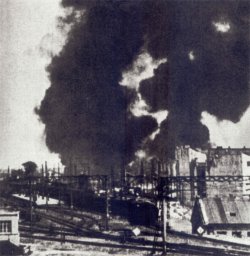
Fire in warehouse on Gniewkowa street.
On 12 August Special Home Army Unit KG AK "Osa" ("Wasp") executed action "Goral" ("Highlander"). Transport with large sum of money was sent from Emission Bank on Bielanska street to Cracow.
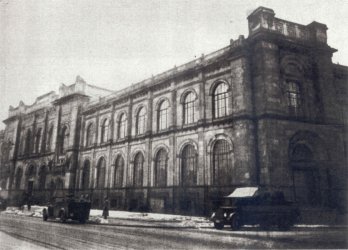 |
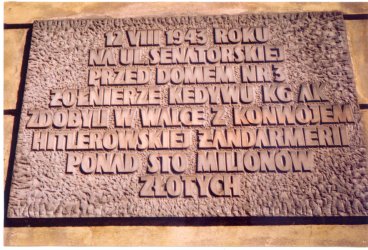 |
Emission Bank (photo on right side - J. Mankowska)
In effect of this brave action near Senatorska street soldiers catch bank car. It contained 106 millions zlote, some Ostmarks, and German marks. Also two submachinegus "Bergman", two carbines, and two pistols "Parabellum" were taken over. Whole action lasted for 2 and a half minutes. Bank car with money went further through Zakroczymska street into Zoliborz, and further Polish Army Avenue, Piaskowa and Tatarska street, into Ostroroga.
Afterwards car went through Gostynska, Plocka, Gorczewska and Swoinskiego street 47 in Wola. There just next to the Wola Cemetery was small gardener's house. And gardener himself was waiting near, his name was Bronislaw Ruchowski aka "Bratek", he was member of Kedyw KG AK.
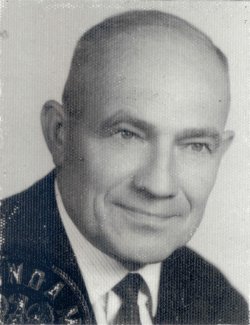
Bronislaw Ruchowski aka "Bratek"
On 11.40 am, sacks with money were put into the whole in the ground and covered with potato leafs. Car went further, afterwards was left on Ordona street. In the night, sacks were putted in the greenhouse, covered with soil, then Gardener planted Begonias on them.
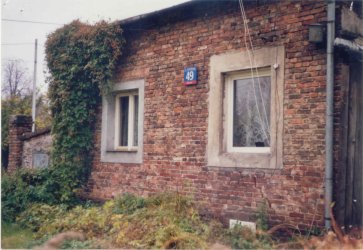
Garneder's house (photo by J. Mankowska)
On 14th of august, big two tons track came to take "crates with vegetables", and "sacks with tomatoes", in which money was hidden. Truck was escorted by 7 soldiers, it has reached its destination on Sliska street, here money were hide in secret compartments. Action was fully succesful.
Last day of August brought People's Guard action of blowing up circumference railroad near Powazki. In the second half of September there were another attempts on destroying it.
On 14 September , unit consisted of 14 men from ODB WOla, burned storages with electronical equipment on Bem street.
On 25th September, combat unit of PG, blown up railroad electrical wires between Bema and Dworska street, causing 4 hours break in train communication.
In October 1943, combat unit "D2" from DB"18" of Kedyw, tried to attack and take over, guards post in Lilpop factory.
Governor Hans Frank, new well what big problem for Nazis is Warsaw. He said:
"If not for Warsaw, we would not have the 4/5 of problems which we have to face, and fight. Warsaw was and still is a sparkling point for all the problems, it's a starting point of all anxiety in this country."
Germans tried new ways for terrorizing citizens. In October they have started large scale roundups. This time not only German police and Wehrmacht took part in them, but also Luftwaffe and Hitlerjugend. Whole parts of crowded streets and districts were surrounded, they were arresting all men, and most of the young women. Those who were captured were standing against the wall, and later loaded on police tracks. Germans did not respect almost any work documents, only those who worked directly for war needs were sent free. Those who were arrested were transported to Pawiak. If somebody was trying to flee he was shot without warning. Also big roundups were organized on Wola.
In response to increasing number of partisans attacks, Germans started public executions. In chosen point of the city, army tracks were headed, they were loaded with prisoners. On place they were dragged out of the trucks and put along the wall. Often mouths of prisoners were filled with plaster, so they were unable to scream. After the execution, bodies were loaded again on trucks and transported away. On those places, flowers were putted almost immediately. Very often women were taking soil wet of blood as a relic to the church. Lot of these murders were held in Wola.
On 22 October 1943, around 10 am, several people were executed on Mlynarska near corner of Wolska street, another group was killed in ghetto ruins, and 10 trolley drivers were shot on Mlynarska 2.
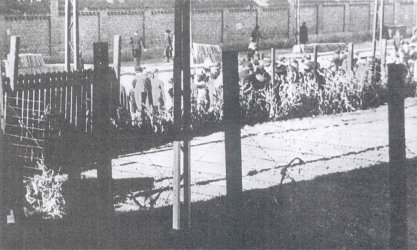
Site of execution on Mlynarska street.
During the day of 26th October, 30 people died under the wall on Leszno street 3. Four days later 10 Pawiak prisoners died on Towarowa corner of Lucka street. Before they died, they managed to shout "Long live Poland!".
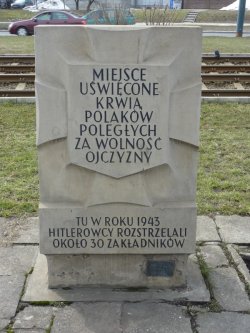 |
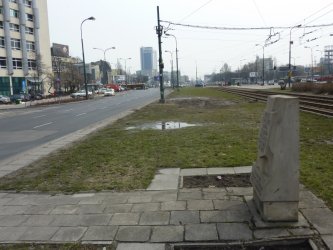 |
Site of execution on Towarowa near Lucka street (photo by M. Janaszek-Seydlitz)
On 9 November, on Plocka street 2, several people were killed.
Nine days later, another murder of group of men and women was made on Wolska street77, near Syrena street.
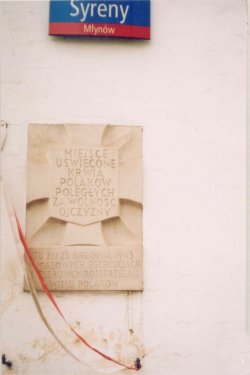
Site of execution on Syrena street (photo by J. Mankowska)
Day before Christmas Eve around 9 am, 43 prisoneres were shot dead on Gorczewska 14 near Plocka street, another 57 on Gorczewska 15.
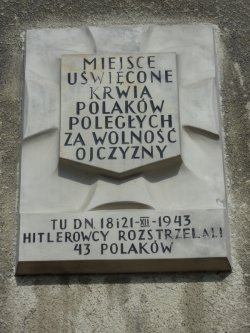 |
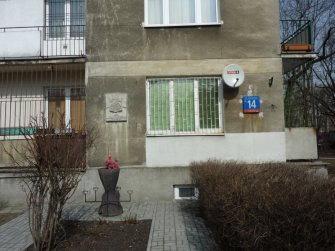 |
Site of execution on Gorczewska 14 (photo by M. Janaszek-Seydlitz)
13 January 1944, brought dead to antoher 14 people on Gorczewska 14, and almost 40 on Gorczewska 15.
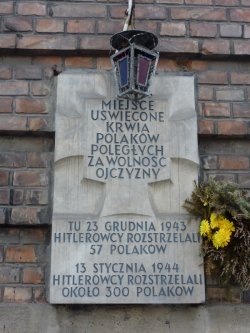 |
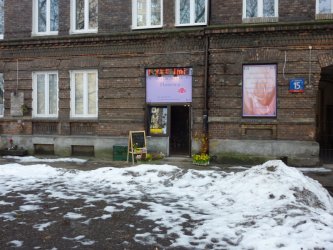 |
Site of execution on Gorczewska 15 (photo M. Janaszek-Seydlitz)
10 February, was date for another killing on Wolska 77.
Underground was however not terrified by Germans barbarism. Poles fought back.
7 September 1943, was date of successful attempt of killing Pawiaks tormentor Frank Burke. Action was made by Kedyw KG AK unit.
Antoher persecutor from Pawiak, Klein was killed by Kedyw KG AK, on crossroads of Leszno and Rymarska street.
During period from December 1943 till March 1944, by units from Kedyw was made action "Topiel". Its purpose was to eliminate the most dangerous leaders of German administration in Warsaw and police informers. Police informer Jozef O. was shot near his house on Plocka street. He was sentenced to death by Special Communal Court. Director of 1st Railroad Police Station Leon Komorowski was executed on 12 January on crossroads of Towarowa and srebrna by unit of DB "3" Kedyw.
In January 1944, compressor in Gasworks was damaged, he was sending gas to the city and to the "Ursus" factory.
In the end of this moth Guardians from PG, threw bottles with petrol to the military workshop on Karolkowa street, damaging 3 trucks.
Unit DB "3" from Kedyw, managed to take over large storages that belonged to Werhmacht, on Kolejowa street near Cetral Railroad Station, partisans were able to take away huge amounts of food for HA.
On 27 March, soldier of Kedyw, planted explosives, on station number 5, precisely under railroad wagon with plane engine. Bomb exploded on 7.40pm. Of course engine was destroyed, and wagon heavily damaged. It was another successful action of this type.
4 April, soldiers from "Kolegium A" of Kedyw, killed in Warsaw-West railroad station, commander of railroad police Karl Schmalz "The Lady" and five of his men. Polish soldiers also captured machineguns, carbines, pistols and ammunition.
On 17 April combat unit of Battalion AL, under name "Czwartacy", attacked guards, and captured their station in Philips factory on Karolkowa street. Their aim was to capture some machineguns. Action was complete success. Two guards were killed. Guns and ammunition were captured, no casualties on Polish side.
On 10th May soldiers from unknown organization, managed to capture 3 machine pistols from guards station in "Doring-Werke" factory.
Biggest achievement for Kedyw soldiers in the beginning of 1944 was successful assassination of Kutschera. SS general Franz Kutschera, was commander of SS and police in Warsaw district since 25th November. Immediately he started aggressive fighting with Polish Underground. Due to his initiative mass roundups and executions started. Announcements about executions were signed with this pattern: "Commander of SS and Police, no name". However management of Underground Fighting, managed to find ho is the commander. Kutschera was given death sentence. On 1st February 1944, soldiers of unit "Pegaz" ("Pegasus") from Kedyw KG AK, attacked exactly on 9.09 am in Aleje Ujazdowskie, between Chopina and Pius street (now Piekna street), Kutschera's car. He was travelling from his home in Roses Avenue 2 to headquarters on Aleje Ujazdowskie 23. Both locations were only in distance o 140 meteres. Action was fully successful, the Warsaw tormentor was dead. In revenge Germans killed 300 Poles, inhabitants of Wola.
Using mass executions in the street Germans counted on breaking Polish fighting spirit, and terrorizing civilians. As said before, these actions were failure. Barrier of fear was long broken, now only hatred spiral was growing bigger.
Situation on European front started to become worse, for Germans. On western front, North Africa was lost to Allies, then in September 1943, they have landed in Italy, and started to capture this country systematically. On 6th June 1944 D-Day action occurred to be success. Eastern front was no better for Nazis. Since the defeat in Stalingrad in February 1943 they were in constant retreat. On 6th January 1944 Soviets reached pre-war Polish border, and in July river Bug.
From November 28 till December 1, 1943 in Teheran was held meeting of leaders from Soviet Union, USA and Great Britain. Stalin, Roosevelt and Churchill, declared to initial agreement about Europa fate after the war. Allies needed Red Army if they were to defeat Nazis. And so they agreed on Stalin demands over area of influence for USSR in Central and Eastern Europe. According to secret protocol, Poland was in Russian influence, which has led to partial loosing of independence for many years. Poland was betrayed by her allies. Polish side did not knew anything about this agreements.
August of 1944 was coming.
compiled by:
Jerzy Janowski
Maciej Janaszek-Seydlitz
Janina Mañkowska
translation: Kamil Kornatka
Copyright © 2010 Maciej Janaszek-Seydlitz. Al rights reserved.